
Tamil Nadu (the Lands of Tamils or Tamil Country) is the southernmost part of Indian Peninsula. It is bordered by union territory of Pondicherry and States of Kerala, Karnataka and Andhra Pradesh. It is bounded by Eastern Ghats on north; by Nilgiri Hills, Anamalai Hills and Kerala on west; by Bay of Bengal in east; by Gulf of Mannar and Palk Strait on southeast and by Indian Ocean on south. It has country’s second longest coastline of about 1,076 km in length. It shares a maritime border with Sri Lanka. Chennai (formerly known as Madras) is the State Headquarters.
Tamil Nadu is the eleventh largest state in India by area and the sixth most populous one. It has a population of 7,21,47,030 as per Census 2011, and covers an area of 1,30,058 sq.km. Its 48.4 % population live in urban areas. It is divided into 32 districts. According to Human Development Index in 2011, Tamil Nadu ranked sixth among Indian States and is second-largest State economy.
Western, southern and north-western parts are hilly and rich in vegetation. Western and Eastern Ghats meet at Nilgiri hills. Western Ghats traverse the entire western border with Kerala, effectively blocking much of rain bearing clouds of south west monsoon from entering State.
Tamil Nadu is mostly dependent on monsoon rains and thereby is prone to droughts when monsoons fail. It has two distinct periods of rainfall: south-west monsoon from June to September with strong southwest winds and north-east monsoon from October to December with dominant north east winds. Annual rainfall of the State is about 945 mm of which 48% is through north-east monsoon and 32% through south-west monsoon.
About 28 dams have been constructed in Nilgiri Hills for impounding, diverting and regulating the water resources for hydro power generation. Nilgiri Plateau is the meeting point of Western and Eastern Ghats. Famous Madumalai Wild Life Sanctuary is in these hills. Kundah forested hills are in broad valley surrounded by steep sided hill ranges/ basin. Whole of this Kundah basin has a number of reservoirs like Mukurthi, Pykara, Parson’s Valley, Emarald, Upper Bhavani etc.
Anamalai forested hills lie in southern portion of Coimbatore district of Tamil Nadu. These are in continuation of Western Ghats and have a good amount of annual rainfall of more than 250 cm. Nature has endowed Anamalai Hills with a rich hydro power potential.
This article deals with State level power organisations, power supply position, sources of electricity, major river systems, hydropower potential, hydropower projects in operation and renovation & modernisation of old generating units of hydro power plants in Tamil Nadu.
State Level Power Organisations
Electricity Department, under Department of Power of Government of Madras was created in 1927 for dealing the matters related to power. Madras State Electricity Board was formed on 1st July 1957 in accordance to Electricity Supply Act of 1948 as successor of Electricity Department. It was responsible for electricity generation, distribution and transmission. It also regulated electricity supply in Tamil Nadu. Later on this Board was renamed as Tamil Nadu Electricity Board (TNEB).
With effect on 1st November 2010, TNEB was re-organised in to Tamil Nadu Generation and Distribution Corporation Limited (TANGEDCO) (responsible for power generation and Tamil Nadu Transmission Corporation Limited (TANTRANSCO) (responsible for power transmission) under section 131 of the Electricity Act of 2003.
Tamil Nadu Electricity Regulatory Commission (TNERC) was established in 1999 under Electricity Regulation Commission Act, 1998 mainly to deal tariff related matters. Tamil Nadu Energy Development Agency (TEDA) acts as a nodal agency to State and Central government, promotes/ develops renewable energy schemes, implements schemes sanctioned by State/Central Government, promotes energy conservation activities and encourages research and development on renewable sources of energy.
Tamil Nadu Electrical Inspectorate (TNEI) is under the control of Energy Department and is responsible for ensuring electrical safety in the State. It is also a nodal agency for energy efficiency and conservation. Tamil Nadu Power Finance and Infrastructure Development Corporation (PowerFin) mobilizes funds for financing power and infrastructure projects. Indian Renewable Energy Development Agency (IREDA) under MNRE provides funds for renewable energy projects.
Power Supply Position
In Tamil Nadu, energy and peak demands have almost been met during April 2016 and the period April 2016 to September 2016. Requirements vis-à-vis availabilities of electricity and peak power demands in Tamil Nadu during these periods are given in Table 1.

Sources Of Electrical Energy
Sector-wise
Tamil Nadu has the third largest installed power generation capacity in India. Total installed capacity of electricity in the State as on 31.08.2016 was 26,260 MW. Sector-wise distribution of installed capacity in the State is indicated below:
Category-wise
Major sources of electricity in Tamil Nadu are thermal power power plants, natural gas power plants, diesel power plants, nuclear power plant, wind mill power plants and hydroelectric power plants. Category-wise installed capacity in Tamil Nadu as on 31.08.2016 is given in Table 2.
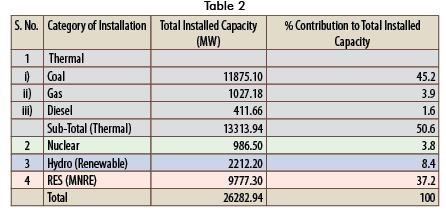
From Table 2, it seen that contribution of hydro installation to total installation in Tamil Nadu is 8.4%.
Major River System
Most of the hydropower development in Nilgiri Hills is covered by east-flowing rivers, namely Bhavani, Kundah and Moyar. Most of east flowing rivers have their origin in eastern slopes of Western Ghats and traverse their course through plains of Deccan Plateau and drain in to Bay of Bengal. Rivers are generally perennial with large variation in flows during monsoon and non-monsoon periods. Because of large variations in river flows, this basin is generally suitable for development of storage type schemes.
Bhavani river is the main tributary of Cauvery and joins it on right bank about 45 km below Metture reservoir. It rises in Salient Valley forests of Malabar (in Kerala) and after traversing in south-easterly direction, it swings round the hill and flows in north-eastern direction before entering in Tamil Nadu. It drains an area of 7,144 sq. Km and flows a distance of 216 km before joining Cauvery at Bhavani. Kundah and Moyar are its important tributaries. Pykara, Sandynallah, Melkodmund and Lone Valley streams are tributaries of Moyar river.
Pykara river rises on Mukurthi peak. After winding through the plateau for 24 km, it plunges down to plain in two falls and a series of cataracts making up in all a total drop of 914.4m in a few kilometres of length offering great potentialities of hydro power generation. Porthimund and Parson’s Valley streams are its tributaries.
Total hydro power development in Anamalai Hills is covered by seven rivers, namely, Nirar, Sholayar, Parambikulam, Thunnakavadu, Peruvaripallam, Aliyar and Oliyar. About 8 dams have been constructed in Anamalai Hills for impounding, diverting and regulating the water resources for hydro power generation and irrigation.
Aliyar and Oliyar rivers flow on eastern side, while remaining five rivers flow on western side of Western Ghats. These rivers have their sources at various elevations ranging from 1158m to 320m. Advantage of the difference in elevations has been taken to generate hydro power by constructing dams across each of these rivers. Parambikulam river, which originates from and traverses Anamalai in Coimbatore district is a tributary of Chalakudi river (Kerala), which ultimately empties in to Arabian Sea.
Hydropower Potential And Status Of Development
In terms of installed capacity, the total hydro power potential identified for Tamil Nadu as per reassessment studies is 1918 MW including station capacity up to 25 MW and is 1693 MW excluding station installed capacity of 25 MW. All the conventional hydro power potential in Tamil Nadu has been harnessed.
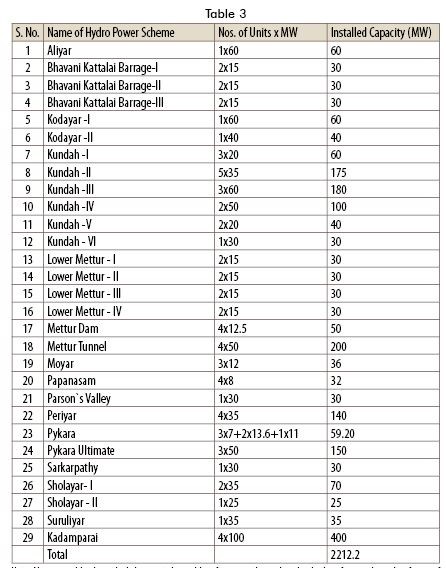
Note: Above capacities do not include up-rated capacities after renovation and modernisation of generating units of some of the hydro power stations.
Hydro Power Schemes In Operation
Pre-Independence Power Scenario
Tamil Nadu has been one of the earliest States in Indian Union, where water was utilized for power generation.
Until about 1908, hydro electricity generation in Madras State was confined to a few tiny hydro plants in tea estates utilising waters of mountain streams and to small hydroelectric installation of Kattery in Nilgiris. The first river tapped for power development by Government of Madras was Pykara in Nilgiri Hills (first 3 units of 6.65 MW each) in 1932 and 1933. Fourth and fifth units of 11 MW each of this plant were commissioned in 1939. Thus, pre-Independence hydro power capacity in Nilgiri Hills and hence in Madara State was 41.95 MW.
Post-Independence Power Scenarios
After Independence of India, hydro power capacities were added during various Five Year and Annual Plans in Tamil Nadu. At present total hydro installed capacity of Tamil Nadu is 2,283.55 MW, 2,212.20 MW from stations having individual station capacity over 25 MW and 71.35 MW from stations having individual station capacity up to 25 MW.
Tamil Nadu has developed almost all type of hydro power schemes: run off river & storage based schemes, surface and underground power houses, high head and low head plants, base load and peak load station, single and multi-purpose schemes, conventional and pumped storage schemes, cascade development, inter-basin transfer of water etc.
Major/ Medium Stations (Station Capacity over 25 MW)
There are 29 hydro power schemes having individual station capacity over 25 MW aggregating to an installed capacity of 2,212.2 MW in operation in Tamil Nadu as on 31.08.2016. These schemes include 28 conventional hydro power schemes aggregating to an installed capacity of 1,812.2 MW and one pumped storage scheme, namely Kadamparai PSS of 400 MW.
Hydroelectric schemes in operation in Tamil Nadu as on 31.08.2016 are listed in table 3.
All hydro power stations in Tamil Nadu are conventional except, one station, viz. Kadamparai, which is pumped storage scheme having reversible generating units. This station adds valuable peaking power capacity to the grid and enables better utilization of thermal/ nuclear energy generation capacities in the State. In addition, it affords conventional energy generation of 77 MUs per annum on an average.
In Generation Mode, machines of Kadamparai PSS operate to cater peak hour power demand for full load depending on level of Kadamparai reservoir and level of Upper Aliyar dam. In Pump Mode, machines of this station operate as pump mode to pump the water from upper Aliyar dam to Kadamparai reservoir during night hours on grid frequency above 49.4 Hz utilizing off peak energy.
Small / Mini / Micro Stations (Station Capacity up to 25 MW)
At present, there are 16 small/ mini/ micro hydroelectric schemes aggregating to an installed capacity of 71.35 MW in operation in Tamil Nadu. These schemes are listed in Table 4.
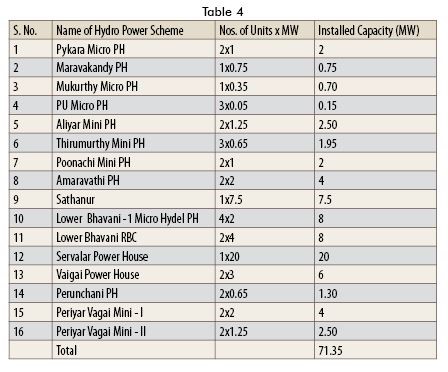
Future Hydroelectric Schemes
As already has been stated, all economically viable hydro power potential in Tamil Nadu has been exploited. There is no conventional hydroelectric scheme under construction in Tamil Nadu. Also, there is no hydroelectric scheme in Tamil Nadu cleared by central Electricity Authority and yet to be taken for implementation. No hydroelectric scheme in Tamil Nadu is under examination in central Electricity Authority for accord of techno-economic clearance.
One pump storage scheme viz. Kundah of 500 MW envisaged for peak power generation was received in Central Electricity Authority. The same was examined and returned in December, 2007 for resubmission after resolution of inter-State aspect.
Renovation And Modernisation Of Hydro Generating Units
Renovation and Modernisation Works Completed
For optimization of resources and to tide over the shortage of electricity in the country, renovation & modernisation, up-rating and life extension (RMU&LE) of the existing old hydroelectric power projects is considered a cost effective option to ensure efficiency, better availability and also to augment capacity addition.
Renovation & modernisation, up-rating, life extension (RMU&LE) and restoration of capacity of the following generating units of hydro power plants in Tamil Nadu have been completed up to 12th Five Year Plan:
- Units 3 & 4 of Kadamparai PSS (100 MW each): Works included Renovation & Modernisation + restoration.
• Units 1&2 of Kundah– III (60 MW each): Works included Renovation & Modernisation
• All the 3 units of Moyar (12 MW each): Works included Renovation & Modernisation + + Life extension.
• Sholayar-I (1×30 MW): Works included Renovation & Modernisation
• All units of Pykara (3×6.65+ 1×11+2x 14): Works included Renovation & Modernisation + Life extension.
• All the 4 units of Papanasam (4 MW each): Works included Renovation & Modernisation + Life extension + up-rating of each unit by 1 MW (Total addition in capacity: 4 MW).
• All units of Mettur Dam (4×10 MW): Works included Renovation & Modernisation + Life extension + up-rating of each unit by 2.5 MW (Total addition in capacity: 10 MW).
• Generating units of Periyar PH (4×35 MW) (Original) have been up-rated from 35 MW each to 42 MW each. Total addition in capacity is 28 MW
Ongoing Renovation and Modernisation Works
• Sholayar PH-1 (2×35 MW): Each unit to be uprated to 42MW (Total addition in capacity:14MW)
• Kodayar PH-II (1×40 MW): Unit would be up rated to 46 MW (Total addition in capacity: 6 MW)
• Moyar PH (3×12 MW): Each unit would be up rated to 14MW (Total addition in capacity: 6 MW)
• Kodayar PH-I (1×60 MW): Unit would be up rated to 70 MW (Total addition in capacity: 10 MW)
In addition to above, some of the generating units of hydro power plants in Tamil Nadu are programmed for Renovation & Modernization & Life Extension and up-rating during the period 2017-22.
Conclusions
Tamil Nadu has been a pioneer State in the field of hydro power development in India. It has harnessed of all its economically exploitable conventional hydro power potential. To meet their power requirements, hydro potential at the existing irrigation dams is being exploited. To meet long term peaking requirements, provision of additional peaking capacity at the existing projects (operating at a very high load factor) is being given consideration.
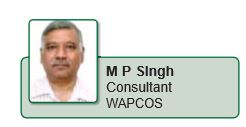
If you want to share thoughts or feedback then please leave a comment below.






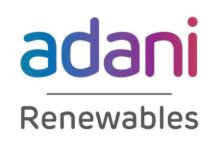


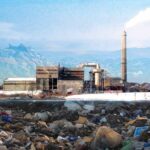









This article gets a thumbs way up from me.
There are some attention-grabbing time limits in this article but I dont know if I see all of them middle to heart. There is some validity however I’ll take hold opinion till I look into it further. Good article , thanks and we would like extra! Added to FeedBurner as nicely